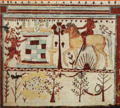Necropoli dei Monterozzi | |
 Painting: Tomb of the Leopards | |
| Location | Tarquinia, Lazio, Italy |
|---|---|
| Region | Etruria |
| Coordinates | 42°15′02″N11°46′12″E / 42.25056°N 11.77000°E |
| Type | Necropolis |
| History | |
| Founded | 7th century BC |
| Site notes | |
| Management | Soprintendenza per i Beni Archeologici dell'Etruria Meridionale |
| Website | Museum and Necropolis of Tarquinia and Cerveteri |
| Official name | Etruscan Necropolises of Cerveteri and Tarquinia |
| Type | Cultural |
| Criteria | i, iii, iv |
| Designated | 2004 (28th session) |
| Reference no. | 1158 |
| Region | Europe and North America |
The Monterozzi necropolis (Italian : Necropoli dei Monterozzi) is an Etruscan necropolis on a hill east of Tarquinia in Lazio, Italy. The necropolis has about 6,000 graves, the oldest of which dates to the 7th century BC. About 200 of the tomb chambers are decorated with frescos. [1]
Contents
The painted tombs of the necropolis are the largest documentation of Etruscan pictorial art, and they are singular testaments to Etruscans' quotidian life, ceremonies, and mythology. [2] Some of the tombs are monumental, cut in rock and topped by tumuli, accessible by means of inclined corridors or stairways. Many different subjects are shown in the frescos, including rituals, animals, magical themes, dance and musical instruments. The best known tombs are the Tomb of the Leopards, of Hunting and Fishing, of the Augurs, of the Triclinium, the Blue Demons and of the Bulls.
Many of the artifacts found in the necropolis and some of the frescos have been brought to the neighboring Tarquinia National Museum in order to preserve them. [3] The paintings and wall decorations of the Tomb of the Baron, discovered in 1827, were also reproduced on the walls of the so-called Etruscan Cabinet in the Castle of Racconigi.
Along with the Banditaccia Necropolis, Monterozzi was designated as a UNESCO World Heritage Site in 2004, notable as "the depiction of daily life in the frescoed tombs, many of which are replicas of Etruscan houses, is a unique testimony to this vanished culture". [4]





























